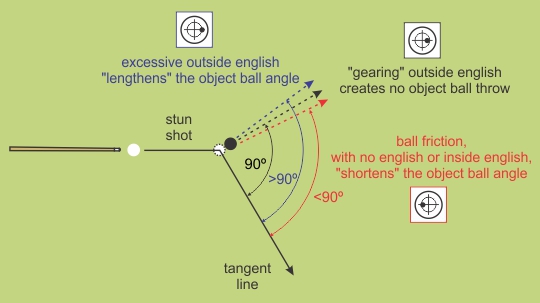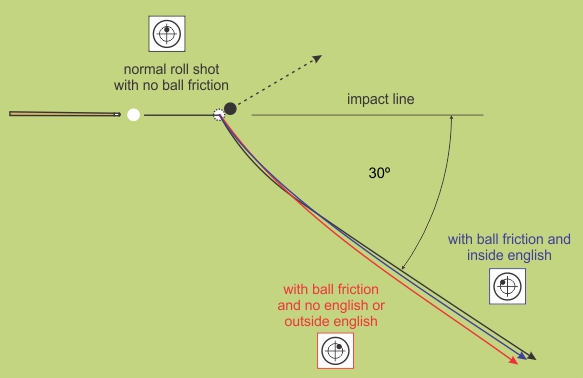What affect does english (sidespin) have on the tangent line and the 90° and 30° rules?
“90° and 30° Rule Follow-up – Part IV: sidespin effects” (BD, May, 2005) shows the effects of sidespin on both the 90° and 30° rules. Here’s Diagram 1 from the article:

For a given contact point on the object ball (OB), the cue ball (CB) tangent line direction does not change with sidespin. Whether the CB has sidespin or not, a stunned CB heads straight down the tangent line (AKA “stun line”). However, the direction and amount of spin on the CB can have a significant effect on OB direction due to throw effects, as shown in the diagram. Here are a good demonstrations of these effects:
In addition to OB throw, spin can also get transferred to the OB. There are many shots where both throw and spin transfer have significant effects, allowing shots that would not be possible otherwise. Numerous examples are illustrated and demonstrated here:
The main purpose for sidespin (when not being used for throw or spin transfer) is to change the CB’s direction after hitting a cushion. For more info, see english terminology and uses.
Here’s Diagram 2 from the sidespin effects article (which does include the effects of slight CB swerve on the way to the OB):

Concerning the 30° rule, when inside sidespin is used, the carom angle can be narrowed slightly, as demonstrated in the following video:
With outside spin shots, the CB will swerve on the way to the OB, increasing the cut angle slightly, which prevents the CB from going forward as much as expected. And with inside english shots, the CB swerve decreases the cut angle slightly, which allows the CB to go more forward than expected. Sidespin also affects how the OB is thrown, but this is not being considered here. For more info, see the throw tutorial.
from 3andstop (in AZB post):
While side spin doesn’t (in and of itself) affect the tangent line from the point of contact on the OB, side spin can and does affect where you contact the OB in order to pocket it.
Therefore, in a tight spot (very common in straight pool) pocketing a ball that would send the CB down an undesirable tangent line, can be adjusted with side spin.
This, because now you are able to contact the OB in a slightly different spot, either thicker or thinner than the contact point with no side spin (depending on which english is used) to pocket it (turn it into the pocket) and change both the contact point and tangent line.
So, in a sort of indirect way, side spin one way or the other, can change the standard tangent line when speaking relative to the pocketing of an object ball.
It will not change the tangent line when speaking of a carom only, hitting the OB in the same spot regardless of english.
Dr. Dave keeps this site commercial free, with no ads. If you appreciate the free resources, please consider making a one-time or monthly donation to show your support:
